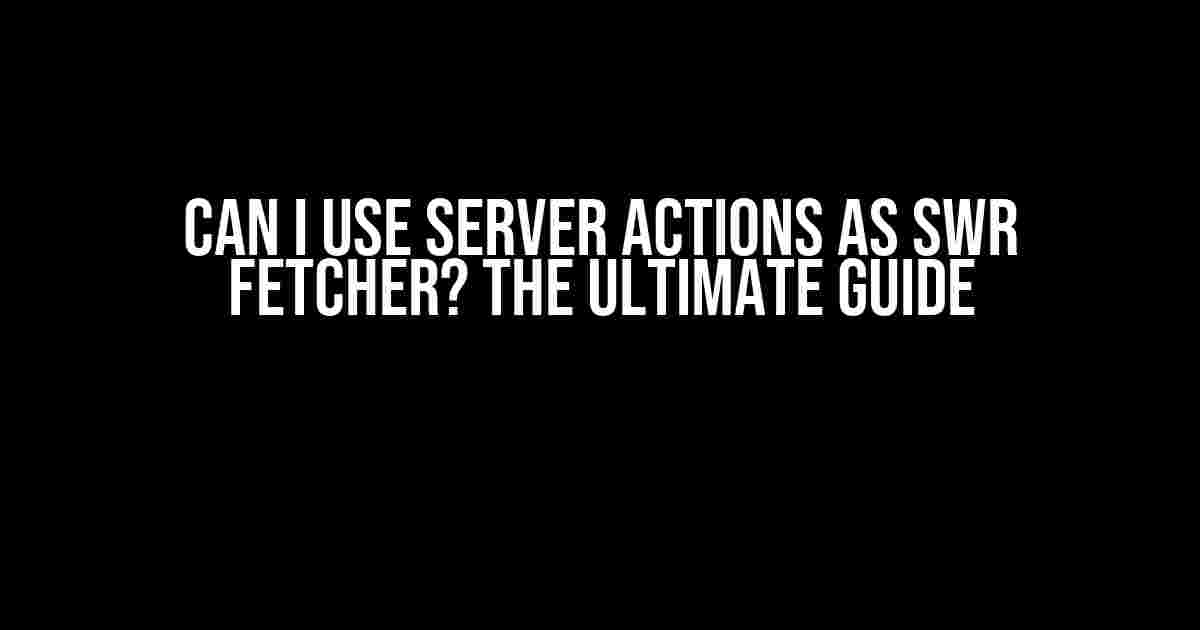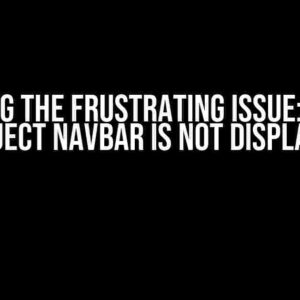Are you tired of dealing with the complexities of API routes and URL parameters? Do you wish there was a simpler way to fetch data from your server? Well, you’re in luck! Server actions can be used as an SWR fetcher, and in this article, we’ll explore how to do just that.
What are Server Actions?
Server actions are a feature in Next.js that allows you to run server-side code without having to create a full-fledged API route. They’re essentially functions that can be called from your client-side code, and they can perform operations like database queries, authentication, and more.
But can you use server actions as an SWR fetcher? The answer is a resounding yes! SWR (SWR stands for “SWR: React Hooks for Remote Data Fetching”) is a popular library for fetching and caching data in React applications, and server actions can be used as a fetcher function to retrieve data from your server.
Why Use Server Actions as an SWR Fetcher?
So why would you want to use server actions as an SWR fetcher? Here are a few reasons:
- Simpler Code**: By using server actions as an SWR fetcher, you can avoid having to create a separate API route for each piece of data you need to fetch. This can lead to simpler, more concise code.
- Faster Development**: With server actions, you can quickly create and test new endpoints without having to set up a full API route. This can speed up your development process and get your app to market faster.
- Improved Security**: Server actions can be secured using Next.js’s built-in authentication and authorization features, making it easier to protect your data and prevent unauthorized access.
How to Use Server Actions as an SWR Fetcher
Now that we’ve covered the why, let’s dive into the how. Here’s an example of how you might use a server action as an SWR fetcher:
// pages/_app.js
import { fetcher } from 'next/data';
import { serverAction } from '../server-actions/get-data';
const useData = () => {
const { data, error } = useSWR('/api/get-data', serverAction);
if (error) return Error: {error.message};
if (!data) return Loading...;
return Data: {data};
};
// server-actions/get-data.js
import { NextApiRequest, NextApiResponse } from 'next';
const serverAction = async (req: NextApiRequest, res: NextApiResponse) => {
// Perform some server-side operation, like a database query
const data = await fetchDataFromDatabase();
return res.status(200).json(data);
};
export default serverAction;
In this example, we’re using the useSWR hook to fetch data from the /api/get-data endpoint. But instead of creating a full API route, we’re using a server action to handle the request. The server action is called with the serverAction function, which performs the necessary server-side operation (in this case, fetching data from a database) and returns the result as JSON.
Advantages and Disadvantages
Like any approach, using server actions as an SWR fetcher has its advantages and disadvantages. Here are some of the key points to consider:
| Advantages | Disadvantages |
|---|---|
|
|
As you can see, using server actions as an SWR fetcher can be a great approach for simple data fetching operations, but it may not be suitable for more complex use cases.
Best Practices for Using Server Actions as an SWR Fetcher
Here are some best practices to keep in mind when using server actions as an SWR fetcher:
- Keep it simple**: Server actions are best suited for simple operations, so try to keep your code concise and focused.
- Use caching wisely**: SWR provides built-in caching, so make sure you’re taking advantage of it to reduce the number of requests to your server.
- Handle errors gracefully**: Make sure you’re handling errors and edge cases properly, so your app doesn’t crash or become unresponsive.
- Test thoroughly**: Test your server actions thoroughly to ensure they’re working as expected, and that your app is behaving as intended.
Conclusion
In conclusion, using server actions as an SWR fetcher can be a great approach for simplifying your data fetching operations and improving the security and performance of your app. By following the best practices outlined in this article, you can take advantage of the benefits of server actions and build a faster, more reliable app.
So, can you use server actions as an SWR fetcher? Absolutely! With the right approach and a little creativity, you can harness the power of server actions to simplify your data fetching and take your app to the next level.
Thanks for reading, and happy coding!
Frequently Asked Question
Get ready to unleash the power of server actions as SWR fetchers! We’ve got the answers to your burning questions.
Can I use server actions as SWR fetchers?
Absolutely! Server actions can be used as SWR fetchers, allowing you to leverage the power of server-side rendering and caching to fetch data for your application.
What are the benefits of using server actions as SWR fetchers?
Using server actions as SWR fetchers provides several benefits, including improved performance, reduced latency, and enhanced security. By leveraging server-side rendering, you can reduce the load on your client-side application and improve the overall user experience.
How do I configure server actions as SWR fetchers?
Configuring server actions as SWR fetchers involves creating a server action that returns the necessary data, and then using the `fetch` function from `next/swr` to fetch the data from the server action. You can also customize the caching behavior and error handling to suit your application’s needs.
Can I use server actions as SWR fetchers with authentication?
Yes, you can use server actions as SWR fetchers with authentication. By leveraging Next.js’ built-in support for authentication, you can secure your server actions and ensure that only authenticated users can access the data.
Are there any limitations to using server actions as SWR fetchers?
While using server actions as SWR fetchers provides many benefits, there are some limitations to consider. For example, server actions may not be suitable for real-time data or high-traffic applications. Additionally, you’ll need to ensure that your server actions are optimized for performance and scalability.



